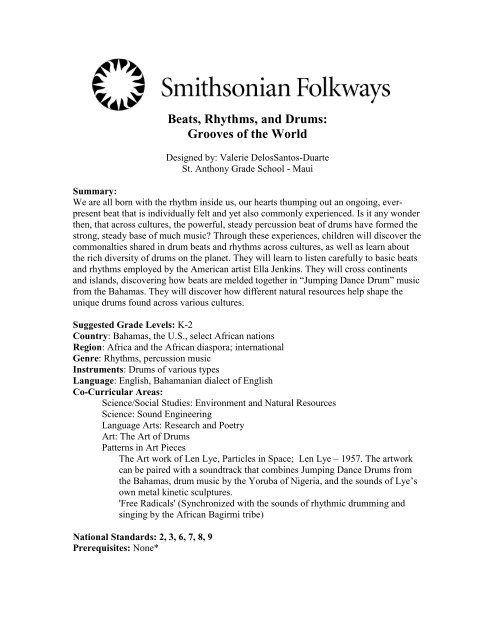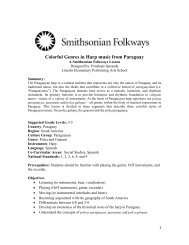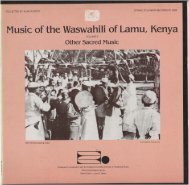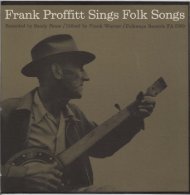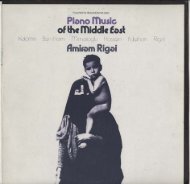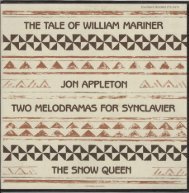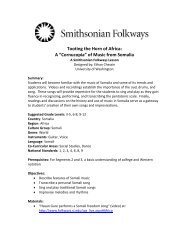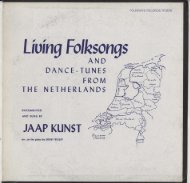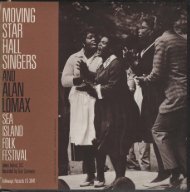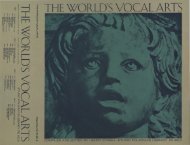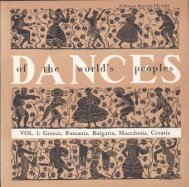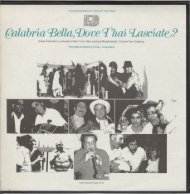Beats, Rhythms, and Drums: Grooves of the World
Beats, Rhythms, and Drums: Grooves of the World
Beats, Rhythms, and Drums: Grooves of the World
Create successful ePaper yourself
Turn your PDF publications into a flip-book with our unique Google optimized e-Paper software.
<strong>Beats</strong>, <strong>Rhythms</strong>, <strong>and</strong> <strong>Drums</strong>:<br />
<strong>Grooves</strong> <strong>of</strong> <strong>the</strong> <strong>World</strong><br />
Designed by: Valerie DelosSantos-Duarte<br />
St. Anthony Grade School - Maui<br />
Summary:<br />
We are all born with <strong>the</strong> rhythm inside us, our hearts thumping out an ongoing, everpresent<br />
beat that is individually felt <strong>and</strong> yet also commonly experienced. Is it any wonder<br />
<strong>the</strong>n, that across cultures, <strong>the</strong> powerful, steady percussion beat <strong>of</strong> drums have formed <strong>the</strong><br />
strong, steady base <strong>of</strong> much music? Through <strong>the</strong>se experiences, children will discover <strong>the</strong><br />
commonalties shared in drum beats <strong>and</strong> rhythms across cultures, as well as learn about<br />
<strong>the</strong> rich diversity <strong>of</strong> drums on <strong>the</strong> planet. They will learn to listen carefully to basic beats<br />
<strong>and</strong> rhythms employed by <strong>the</strong> American artist Ella Jenkins. They will cross continents<br />
<strong>and</strong> isl<strong>and</strong>s, discovering how beats are melded toge<strong>the</strong>r in “Jumping Dance Drum” music<br />
from <strong>the</strong> Bahamas. They will discover how different natural resources help shape <strong>the</strong><br />
unique drums found across various cultures.<br />
Suggested Grade Levels: K-2<br />
Country: Bahamas, <strong>the</strong> U.S., select African nations<br />
Region: Africa <strong>and</strong> <strong>the</strong> African diaspora; international<br />
Genre: <strong>Rhythms</strong>, percussion music<br />
Instruments: <strong>Drums</strong> <strong>of</strong> various types<br />
Language: English, Bahamanian dialect <strong>of</strong> English<br />
Co-Curricular Areas:<br />
Science/Social Studies: Environment <strong>and</strong> Natural Resources<br />
Science: Sound Engineering<br />
Language Arts: Research <strong>and</strong> Poetry<br />
Art: The Art <strong>of</strong> <strong>Drums</strong><br />
Patterns in Art Pieces<br />
The Art work <strong>of</strong> Len Lye, Particles in Space; Len Lye – 1957. The artwork<br />
can be paired with a soundtrack that combines Jumping Dance <strong>Drums</strong> from<br />
<strong>the</strong> Bahamas, drum music by <strong>the</strong> Yoruba <strong>of</strong> Nigeria, <strong>and</strong> <strong>the</strong> sounds <strong>of</strong> Lye’s<br />
own metal kinetic sculptures.<br />
'Free Radicals' (Synchronized with <strong>the</strong> sounds <strong>of</strong> rhythmic drumming <strong>and</strong><br />
singing by <strong>the</strong> African Bagirmi tribe)<br />
National St<strong>and</strong>ards: 2, 3, 6, 7, 8, 9<br />
Prerequisites: None*
Objectives:<br />
Students will:<br />
discover <strong>the</strong> commonalties in beat, rhythms, <strong>and</strong> drums that are shared by<br />
cultures<br />
learn to listen carefully to basic beats <strong>and</strong> rhythms<br />
explore <strong>the</strong> phenomenon <strong>of</strong> <strong>the</strong> drum<br />
discover how different natural resources <strong>of</strong> an area shape <strong>the</strong> unique kinds <strong>of</strong><br />
drums found in different cultures<br />
Materials:<br />
Smithsonian Folkways Links<br />
Ella Fitzgerald for Children – Drum <strong>Rhythms</strong><br />
Music Clips http://www.folkways.si.edu/albumdetails.aspx?itemid=2106<br />
Jumping Dance <strong>Drums</strong>:<br />
Music Clips<br />
http://www.folkways.si.edu/TrackDetails.aspx?itemid=11717<br />
Liner Notes<br />
http://media.smithsonianfolkways.org/liner_notes/folkways/FW04502.pdf<br />
Music Clips<br />
http://www.folkways.si.edu/albumdetails.aspx?itemid=853<br />
Liner Notes<br />
http://media.smithsonianfolkways.org/liner_notes/folkways/FW04440.pdf<br />
Smithsonian Folkways’ online jazz exhibition<br />
http://www.folkways.si.edu/jazz/mixer.aspx<br />
Large Map Mural <strong>of</strong> <strong>the</strong> <strong>World</strong><br />
General Classroom Supplies (Paper, clips, markers pencils, stones, popsicle sticks,<br />
rubber b<strong>and</strong>s, etc)<br />
First Lesson: Good Vibrations (National St<strong>and</strong>ard #8)<br />
Introduce how sound is made (Vibration Activity)<br />
Note: This experience is needed for making sense <strong>of</strong> <strong>the</strong> engineering project in <strong>the</strong> third<br />
lesson segment. It is also a useful assessment <strong>of</strong> student underst<strong>and</strong>ing <strong>of</strong> sound.<br />
a) Introduce a musical instrument with which students are all familiar, such as a<br />
drum. Explain <strong>the</strong> acoustic <strong>and</strong> functional properties <strong>of</strong> its sound-making. If a<br />
drum is not available, simply use an empty c<strong>of</strong>fee can with a cover <strong>and</strong> <strong>the</strong><br />
bottom cut out. If using a c<strong>of</strong>fee can, remember to smooth <strong>the</strong> edges before<br />
using it with students. Place some small pieces <strong>of</strong> paper on <strong>the</strong> top <strong>of</strong> <strong>the</strong> drum<br />
while holding <strong>the</strong> skin <strong>of</strong> <strong>the</strong> drum, so that when tapped, <strong>the</strong> drum cannot<br />
vibrate. Notice what happens to <strong>the</strong> paper pieces: Nothing. Repeat, this time<br />
letting go <strong>of</strong> <strong>the</strong> skin before tapping. Notice that a sound is made, <strong>and</strong> that <strong>the</strong><br />
paper pieces move <strong>and</strong> “vibrate.”<br />
b) Have students experiment with sounds, seeing <strong>and</strong> feeling <strong>the</strong> different<br />
2
vibrations made when sound occurs (for example, hold a ruler on <strong>the</strong> edge <strong>of</strong> a<br />
desk, with most <strong>of</strong> <strong>the</strong> ruler sticking over <strong>the</strong> desk. Hit <strong>the</strong> ruler <strong>and</strong> listen to<br />
<strong>the</strong> sound while watching <strong>the</strong> vibration; Or strum a rubber b<strong>and</strong> stretched<br />
across fingers <strong>and</strong> listen to, see <strong>and</strong> feel <strong>the</strong> vibrations.) Help students<br />
underst<strong>and</strong> that drums depend on <strong>the</strong> activation <strong>of</strong><br />
vibrations—mostly by human h<strong>and</strong>s or mallets <strong>and</strong> sticks held by human<br />
h<strong>and</strong>s.<br />
Assessment: Students will be able to explain <strong>and</strong> demonstrate <strong>the</strong> principle <strong>of</strong> sound<br />
vibration on an instrument or found-sound.<br />
Second Lesson: There’s A Pattern In That Rhythm (National St<strong>and</strong>ards #2, 3, 6, 8, 9)<br />
a) Have students listen to <strong>the</strong>ir own personal rhythm: <strong>the</strong>ir heart beat. Have<br />
<strong>the</strong>m find <strong>the</strong>ir heart beat or <strong>the</strong>ir pulse, <strong>and</strong> tap out <strong>the</strong> rhythm <strong>the</strong>y hear: an<br />
endless pattern <strong>of</strong> steady beats.<br />
b) Review <strong>the</strong> meaning <strong>of</strong> “patterns” as established in math <strong>and</strong> <strong>the</strong> visual arts.<br />
c) Focus on how a steady beat is a pattern, <strong>and</strong> how o<strong>the</strong>r rhythms are also<br />
patterns <strong>of</strong> sound.<br />
d) Have students create visual patterns <strong>and</strong> assign a sound to each “picture” that<br />
<strong>the</strong>y can perform with body percussion.<br />
For example: =clap =stomp<br />
The pattern could be performed in this manner:<br />
clap-clap-clap-stomp clap-clap-clap-stomp<br />
Perform various created rhythm patterns.<br />
After clapping, snapping, <strong>and</strong> stomping <strong>the</strong> rhythms created from <strong>the</strong>se<br />
visual patterns, ask students to transition to drums.<br />
The pattern could now be performed in this manner:<br />
HHHL HHHL<br />
BBBD BBBD<br />
[H= higher L=lower, B=brighter D=duller]<br />
e) Without visual pictures, challenge students (working independently with<br />
partners <strong>and</strong>/or in small groups) to create musical patterns using <strong>the</strong>ir pencils<br />
(or palms/fingers). Have <strong>the</strong>m play around with different patterns <strong>and</strong> use<br />
different surface areas to “drum” <strong>the</strong>se patterns. What do <strong>the</strong>y notice? What<br />
kinds <strong>of</strong> surfaces make higher pitches – drums, drums sticks, palms with open<br />
fingers or closed fingers? Which make lower pitches?<br />
f) Introduce Ella Jenkins Folkways site <strong>and</strong> have students listen attentively to <strong>the</strong><br />
track with drum rhythms (#113).<br />
http://www.folkways.si.edu/albumdetails.aspx?itemid=2106<br />
3
g) Practice <strong>the</strong> rhythm patterns that are clearly detectable, with <strong>and</strong> without <strong>the</strong><br />
recording. Students will learn this first rhythm pattern toge<strong>the</strong>r as a group <strong>and</strong><br />
recreate it on <strong>the</strong>ir “desk drums.” Then have students work in groups, with<br />
each group learning ano<strong>the</strong>r rhythm from <strong>the</strong> Ella Jenkins collection. They can<br />
listen <strong>and</strong> learn directly from <strong>the</strong> recording or as prescribed by <strong>the</strong> teacher<br />
(Tracks 114 -122). Each group practices <strong>and</strong> performs its own rhythm for <strong>the</strong><br />
class, <strong>and</strong> group members are <strong>the</strong>n charged with teaching o<strong>the</strong>r groups <strong>the</strong><br />
rhythm <strong>the</strong>y learned.<br />
Assessment: Students will be able to decipher <strong>and</strong> discriminate rhythm patterns <strong>and</strong> to<br />
perform <strong>the</strong>m using body percussion <strong>and</strong> found-sound instruments.<br />
Third Lesson: What’s That Rhythm <strong>and</strong> Where Is It From?<br />
(National St<strong>and</strong>ards #2, 3, 6, 8, 9)<br />
a) Introduce <strong>the</strong> idea that <strong>the</strong>re are many types <strong>of</strong> music from many<br />
cultures throughout <strong>the</strong> world. Emphasize that, invariably, drums are used<br />
throughout <strong>the</strong> world to create rhythm.<br />
b) Have students listen to a musical clip from <strong>the</strong> Bahamas in which <strong>the</strong>re are<br />
three prominent rhythms:<br />
http://www.folkways.si.edu/TrackDetails.aspx?itemid=11717. Ask <strong>the</strong>m to<br />
focus on <strong>the</strong> drum beat, <strong>and</strong> to show it, say it, clap it, tap it, dance it - create<br />
some type <strong>of</strong> basic visual notation for it.<br />
c) Have students listen to <strong>the</strong> recording again, with eyes closed, focusing on high<br />
<strong>and</strong> low, bright <strong>and</strong> dull sounds. Ask <strong>the</strong>m to think about what <strong>the</strong> drum might<br />
look like based on what <strong>the</strong>y hear, <strong>and</strong> to describe <strong>the</strong> drum by its skin, size,<br />
<strong>and</strong> shape. Have drums or drum-like c<strong>of</strong>fee cans on h<strong>and</strong> for students to<br />
experiment with as <strong>the</strong>y try to imitate <strong>the</strong>se sounds. Ask students to draw <strong>the</strong>ir<br />
vision <strong>of</strong> <strong>the</strong> drum in <strong>the</strong>ir engineering journal. Using both diagrams <strong>and</strong><br />
words, ask <strong>the</strong>m to explain why <strong>the</strong>y think <strong>the</strong> drum has <strong>the</strong> design <strong>the</strong>y<br />
envision. Following <strong>the</strong> writing exercise, have students take a 30-second<br />
partner share-time to discuss <strong>the</strong>ir vision.<br />
4
d) Introduce <strong>the</strong> natural <strong>and</strong> man-made resources that are readily available to<br />
people <strong>of</strong> a given area. Having looked at <strong>the</strong>se, ask students to think about <strong>the</strong><br />
possible look <strong>of</strong> <strong>the</strong>ir drum again. They should make modifications to <strong>the</strong>ir<br />
vision as needed. As homework, ask students to search <strong>the</strong> environment<br />
(natural <strong>and</strong> manmade environments) for things which could be used to create<br />
drums <strong>and</strong> o<strong>the</strong>r percussion instruments as well.<br />
e) In an about-face, have students st<strong>and</strong> around a large map mural on <strong>the</strong> floor<br />
(preferably one that <strong>the</strong>y created). Review <strong>the</strong> rhythms from yesterday’s<br />
“Jumping Dance <strong>Drums</strong>” musical clip. Although it features three rhythms <strong>and</strong><br />
various instruments in it, focus on <strong>the</strong> drum rhythm. (The rhythm is as<br />
follows, syllabically: don da da don don da don don don. Match it to <strong>the</strong><br />
recording.)<br />
f) Listen carefully to <strong>the</strong> piece again. Ask students to imagine where <strong>the</strong><br />
music might be from. Have <strong>the</strong>m move to that place on a large mural map<br />
which has been stretched across <strong>the</strong> floor. Discuss responses. Then have <strong>the</strong>m<br />
move to <strong>the</strong> place where <strong>the</strong> song is actually from - <strong>the</strong> Bahamas, in <strong>the</strong><br />
Caribbean. (Consider that students may choose <strong>the</strong> African continent as <strong>the</strong><br />
source <strong>of</strong> <strong>the</strong> piece, <strong>and</strong> how it will be necessary to trace <strong>the</strong> journey across<br />
<strong>the</strong> Atlantic Ocean from <strong>the</strong>ir “guess” <strong>and</strong> <strong>the</strong> real course.)<br />
g) Students can take this rhythm, <strong>and</strong> instead <strong>of</strong> using drums, repeat <strong>the</strong> rhythm<br />
using ano<strong>the</strong>r “instrument.” Using typical materials <strong>and</strong> student supplies<br />
found in a classroom (pencils, clips, markers, stones, popsicle sticks, rubber<br />
b<strong>and</strong>s, paper, etc), encourage students to create <strong>the</strong>ir own “musical<br />
instrument” to repeat <strong>the</strong> “Jumping Dance <strong>Drums</strong>” drum rhythm. Students can<br />
work independently, as partners, or in small groups.<br />
Assessment: Students will be able to explain <strong>and</strong> demonstrate <strong>the</strong> sonic effects <strong>of</strong> certain<br />
elements <strong>of</strong> percussion instruments, <strong>and</strong> <strong>the</strong> origins <strong>of</strong> different rhythms <strong>and</strong> percussion<br />
instruments on a global map.<br />
5
Fourth Lesson: <strong>Drums</strong> From Around The <strong>World</strong> (National St<strong>and</strong>ards #6, 9)<br />
a) Ask students to research <strong>the</strong> drums in various regions <strong>of</strong> <strong>the</strong> world <strong>and</strong><br />
discover from what materials <strong>the</strong>y are constructed. They can write about or<br />
diagram <strong>the</strong>ir drum, using <strong>the</strong> internet as a source, including <strong>the</strong> Smithsonian<br />
Folkways website <strong>of</strong> liner notes on percussion traditions. They attempt to<br />
identify how drums are made <strong>and</strong> how natural resources used to create<br />
rhythms. Students can keep written, diagrammatic, <strong>and</strong>/or web-based notes, as<br />
well as incorporate o<strong>the</strong>r means <strong>of</strong> notation. For example, <strong>the</strong>y may write a<br />
chant or song about <strong>the</strong> information. Use <strong>the</strong> Smithsonian Folkways website,<br />
texts <strong>and</strong> primary sources to support student research.<br />
b) Have students create a poem to describe <strong>the</strong>ir drum. They can choose any<br />
poetic form, or rhyme scheme, including free flow. The poem should name<br />
<strong>the</strong> drum, describe what it is made from, <strong>and</strong> express any o<strong>the</strong>r information<br />
about <strong>the</strong> drum depending that <strong>the</strong> student found to be valuable. Students will<br />
<strong>the</strong>n create an art piece to go with <strong>the</strong> poem <strong>and</strong> add it to <strong>the</strong> large mural map<br />
from above. An example <strong>of</strong> drum poem follows:<br />
Coconut tree trunks <strong>and</strong> shark skin<br />
Strong <strong>and</strong> sturdy, brought toge<strong>the</strong>r to bring stories <strong>and</strong> music to life<br />
The pahu drum thumps out rhythms <strong>and</strong> beats<br />
As oli are heard, deep <strong>and</strong> throaty<br />
Joined with kahiko dancers to tell stories <strong>of</strong> knowledge <strong>and</strong> wisdom,<br />
power <strong>and</strong> love, warning, <strong>and</strong> danger….. <strong>and</strong> life<br />
c) As students find information, encourage discussion <strong>and</strong> sharing <strong>of</strong> internet<br />
sites, books, videos, photos, <strong>and</strong> first-h<strong>and</strong> accounts (from parents, community<br />
members, et al). Use Venn-Diagrams to compare <strong>and</strong> contrast <strong>the</strong> similarities<br />
<strong>and</strong> unique qualities <strong>of</strong> different drums (including <strong>the</strong> kinds <strong>of</strong> sounds that<br />
<strong>the</strong>y “make’).<br />
d) Help students to imagine particular music without <strong>the</strong> presence <strong>of</strong> <strong>the</strong> drum’s<br />
beat <strong>and</strong> rhythm. Reference <strong>the</strong> Smithsonian Folkways online jazz exhibition:<br />
http://www.folkways.si.edu/jazz/mixer.aspx.<br />
e) Engage in a class discussion that considers <strong>the</strong> following topics: Why do you<br />
think drums are so prevalent in <strong>the</strong> music <strong>of</strong> so many cultures? How are drums<br />
<strong>the</strong> same across different cultures? How are <strong>the</strong>y different? Why do you think<br />
this might be? Can one find similar rhythms in <strong>the</strong> different cultures that our<br />
classmates chose to research?<br />
Assessment: Students will be able to craft a poem <strong>and</strong> an art piece inspired by drums <strong>and</strong><br />
percussion music.<br />
6
Fifth Lesson: Create Your Own Drum; Share Your <strong>Rhythms</strong><br />
(National St<strong>and</strong>ards #2, 3, 6, 8)<br />
a) Encourage students to engage in an engineering exercise that challenges <strong>the</strong><br />
use <strong>of</strong> new-found knowledge in both science <strong>and</strong> music. They can create <strong>the</strong>ir<br />
own drum (individually or in pairs) using supplies from <strong>the</strong> class, from home,<br />
<strong>and</strong> from <strong>the</strong>ir neighborhood or community environment. The drum should<br />
reflect discoveries made throughout this unit relative to sound <strong>and</strong> vibration.<br />
b) Using <strong>the</strong>ir newly-constructed drums, students can <strong>the</strong>n create rhythm(s) <strong>and</strong><br />
“commit it to memory” in some way (visually, orally, through movement,<br />
<strong>and</strong>/or recorded with line notation, technology, etc). Students <strong>the</strong>n share <strong>the</strong>ir<br />
drums <strong>and</strong> <strong>the</strong>ir rhythms (<strong>and</strong> recorded means <strong>of</strong> retaining it) with a partner.<br />
Once <strong>the</strong> partners have learned <strong>the</strong> two rhythms on <strong>the</strong>ir drum, <strong>the</strong>y can <strong>the</strong>n<br />
share it with <strong>the</strong> class <strong>and</strong> record it for prosperity.<br />
7


